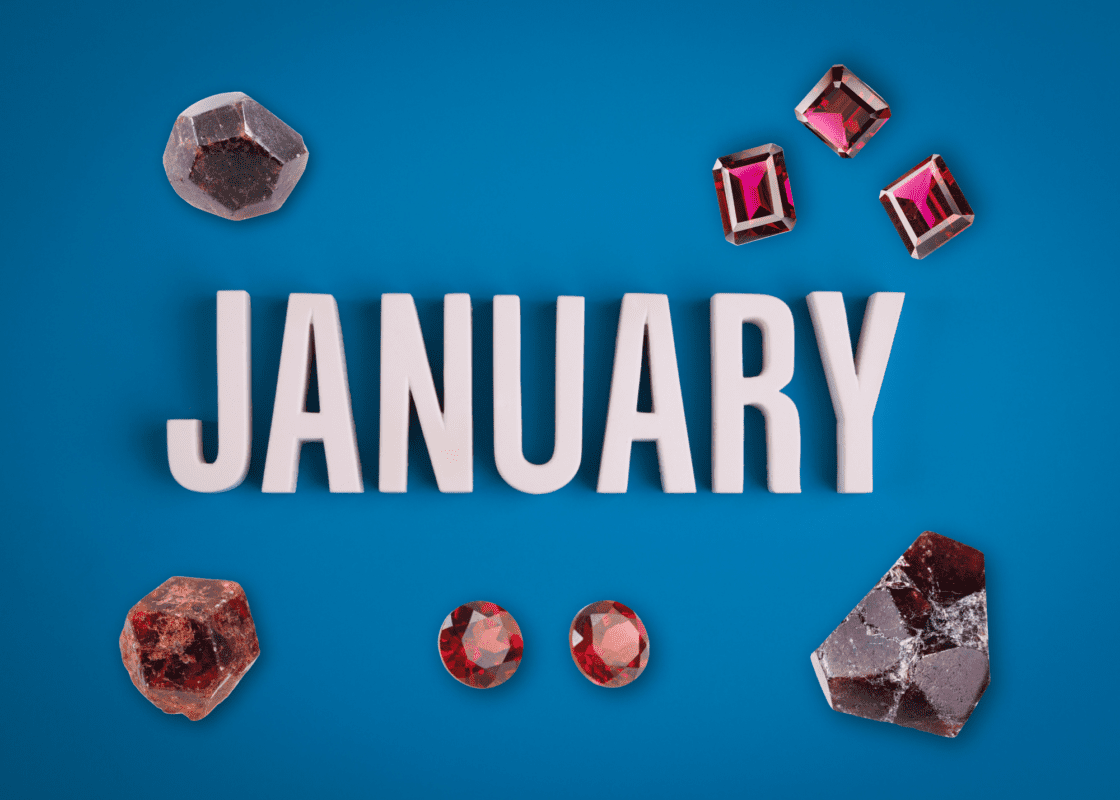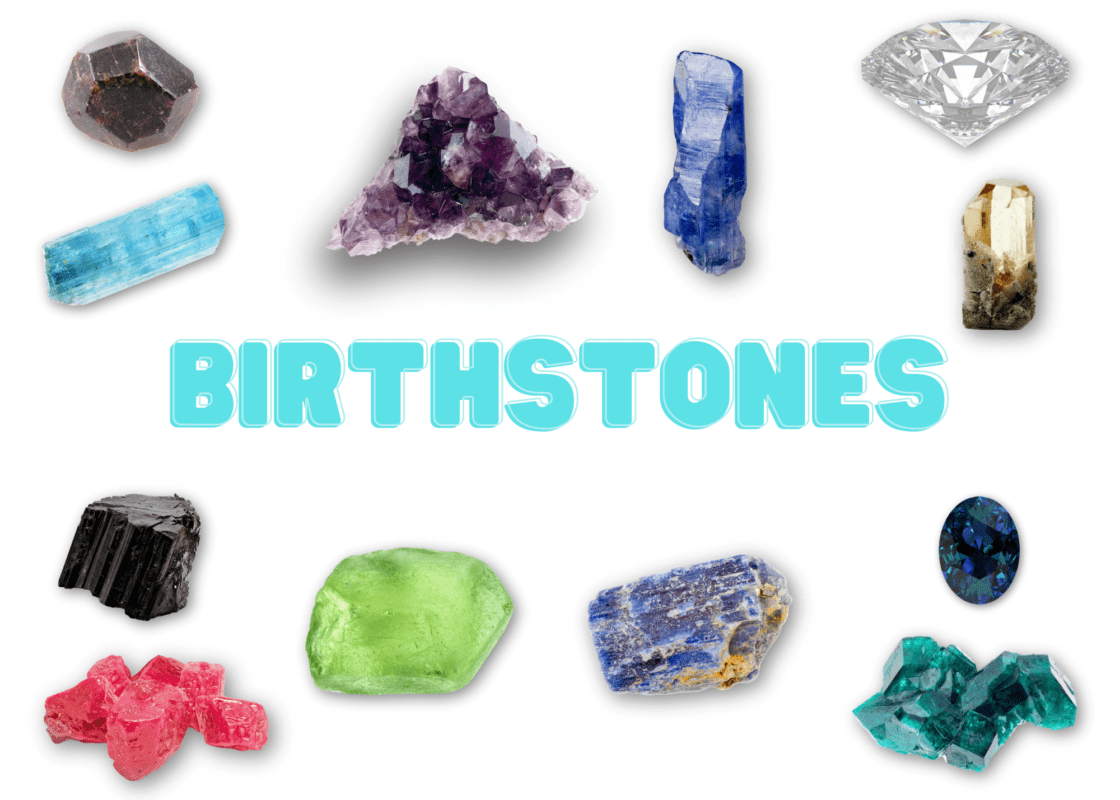Subtotal: $74.95
Introduction
Garnet, the birthstone for January, is renowned not just for its beauty in jewelry but also for its significance in gemological studies and specimen collections. This versatile gemstone captures the fascination of collectors and scientists alike, due to its unique properties and the breadth of its varieties. Garnet’s appeal extends beyond its traditional use in adornments, reaching into the realms of geological research and educational collections, where it serves as a window into the dynamic processes of the Earth’s crust.
Garnet Overview
Quick Facts About Garnet:
- Color Range: Garnet is celebrated for its spectacular diversity in color, from the classic deep reds to vibrant greens and even rare blues.
- Mohs Hardness: Typically ranges between 6.5 to 7.5, making it durable yet more delicate compared to harder gemstones like diamonds.
- Cultural Significance: Across various cultures, garnet is esteemed not only for its aesthetic appeal but also for its purported metaphysical properties such as protection, prosperity, and health.
Detailed Table of Garnet Varieties:
| Variety | Color Range | Common Sources | Mohs Hardness | Notable Properties |
|---|---|---|---|---|
| Almandine | Deep red, violet red | India, Brazil, U.S. | 7.5 | Most common type of garnet |
| Rhodolite | Purplish red, rose red | India, Sri Lanka, Brazil | 7 – 7.5 | Valued for its vivid colors |
| Pyrope | Dark red | U.S., South Africa, China | 7 – 7.5 | Known for its transparency |
| Spessartine | Orange to reddish-brown | Namibia, Nigeria, Brazil | 7.5 | Bright orange colors |
| Grossular | Colorless, yellow, green, teal | Canada, South Africa, Zambia | 6.5 – 7 | Includes varieties like tsavorite and hessonite |
| Andradite | Yellow, green, brown, black | Russia, Italy, U.S. | 6.5 – 7 | Includes rare demantoid |
| Demantoid | Vivid green, emerald green | Russia, Namibia, Iran | 6.5 – 7 | High brilliance and fire |
| Tsavorite | Bright green | Kenya, Tanzania | 7 – 7.5 | Rich, vibrant green color |
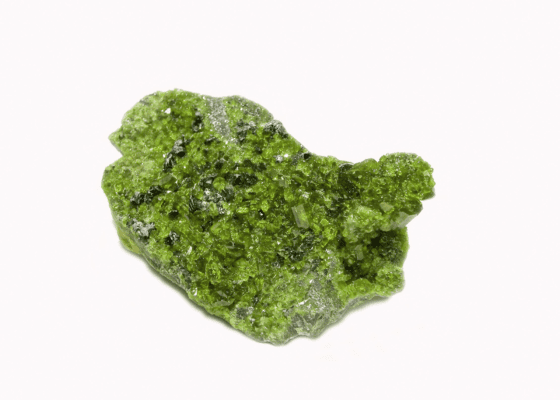
This table highlights the extensive color range and sources of various garnet types, along with their hardness and other gemological characteristics that make them fascinating both as jewelry pieces and as subjects of scientific study. Garnets from different locales exhibit unique hues and qualities, reflecting the geological conditions under which they formed. This diversity not only enhances their value as collectibles but also as educational tools for understanding mineralogy and geology.
Historical and Cultural Significance
Historical Use of Garnet Garnet’s use as a cherished gemstone dates back thousands of years. Ancient Egyptians valued garnets not only as beautiful adornments but also as symbols of life. They were often included in pharaohs’ tombs as gifts for the afterlife. During the Roman Empire, garnet was commonly used to carve signet rings used for stamping the wax on important documents, a testament to its durability and widespread appreciation.
In the Middle Ages, garnets were favored by clergy and nobility. Their deep red color was associated with Christ’s sacrifice, making them popular in religious artifacts and decorations. The gemstone was also embedded in the armor of Crusaders as a protective talisman against injuries and death.

Cultural and Astrological Significance In addition to its historical uses, garnet holds a significant place in folklore and astrology. It is traditionally believed to protect its wearer from nightmares, guide them in the dark, and ward off evil spirits. This protective quality makes garnet a popular choice for travelers’ amulets.
Astrologically, garnet is linked with the zodiac signs Capricorn and Aquarius. It is thought to energize Capricorns and bring them motivation, and for Aquarians, it’s believed to inspire creativity and enhance intuition. The stone is also known to foster loyalty and affection, embodying traits like trust, friendship, and love which are celebrated across various cultures.
Geological Characteristics
Formation of Garnet Garnet forms in both igneous and metamorphic rocks under high temperatures and pressures, which contributes to its excellent hardness and durability. It is commonly found in metamorphic rocks such as schist and gneiss and in some igneous rocks like granite and volcanic rock. The conditions of its formation make garnet widespread globally, appearing in diverse geological environments.
Chemical and Physical Properties Chemically, garnets are a group of silicate minerals that share a similar crystal structure but vary greatly in chemical composition. The basic formula for garnet is X₃Y₂(SiO₄)₃, where X and Y are positions occupied by different metal ions like calcium, magnesium, aluminum, and iron. This variation in chemical makeup between the garnet types results in the vast array of colors and properties seen in this gem family. For example, the presence of chromium and vanadium in certain garnets can lead to vibrant green hues, while iron and manganese can produce deep reds.
The unique blend of elements within different garnet species explains not only the range of colors but also the variations in density, refractive index, and other optical qualities that make each type of garnet distinct. This diversity is what makes garnet particularly appealing to both gem collectors and geological researchers, offering a rich field of study into the interactions between mineral chemistry and environmental conditions.
Garnet Varieties and Colors
In-depth Look at Various Garnet Types
- Almandine: The most common type of garnet, almandine is typically deep red with a hint of violet. It is valued for its hardness and is widely used in jewelry.
- Rhodolite: A blend of almandine and pyrope, rhodolite garnets are known for their vibrant, purplish-red hues. They are highly sought after for their clarity and color.
- Pyrope: Known for a deep, fiery red that sometimes contains brownish tones, pyrope is often associated with the classic garnet look.
- Demantoid: One of the rarest and most valuable garnets, demantoid features a striking green color and is prized for its brilliance and fire, often exceeding that of diamonds.
- Tsavorite: Another green garnet, tsavorite is known for its bright, vivid shades ranging from pure green to deep forest hues. It is highly treasured due to its clarity and color depth.
Newer Varieties like Lotus Garnet
- Lotus Garnet: Discovered in 2015 in Madagascar, Lotus garnet is a fascinating new addition to the garnet family. It exhibits a unique pinkish-orange to orangey-pink hue and is found alongside rhodolite garnet and spinel. Its discovery has intrigued gemologists and collectors alike due to its unique color properties and composition.
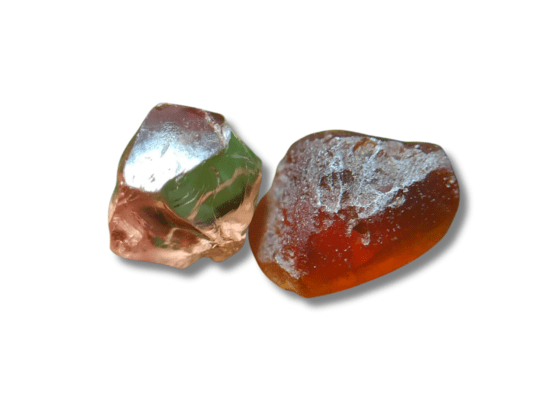
Global Sources and Mining
Comprehensive Listing of Garnet Sources Worldwide
- Traditional Locations: Historically, Bohemia (now part of the Czech Republic) was known for its pyrope garnets, which adorned Victorian jewelry. These garnets were famed for their beautiful deep red colors.
- Contemporary Mines: Today, the most significant sources of high-quality garnets are in Africa and Asia. Countries like Kenya, Tanzania, and Madagascar are renowned for tsavorite and demantoid garnets, while India and Sri Lanka also provide a variety of garnets.
Focus on Artisanal Mining
- Artisanal mining plays a crucial role in the garnet market, particularly in regions like Africa where small-scale miners are responsible for a significant portion of the world’s garnet supply. These miners often work in challenging conditions but are vital in bringing to market some of the most unique and high-quality garnets. This sector not only supports local economies but also contributes to the global diversity of available garnets, offering gemstones that might not be feasible to mine on a larger scale.
These garnet varieties and mining insights highlight the complexity and global nature of the garnet market, offering collectors and enthusiasts a rich tapestry of choices and stories behind each stone. Whether for their aesthetic appeal or their fascinating origins, garnets continue to be a focal point of interest in the gemological world.
Collection and Care
Advice on Collecting Garnet Specimens Collecting garnet specimens can be a rewarding hobby for gem enthusiasts and mineral collectors. When adding garnet to a collection, consider the following:
- Variety and Provenance: Focus on diversity by including various types of garnets from different locations. Provenance can significantly enhance the value and interest of your specimens.
- Handling and Storing: Garnets, while fairly hard, can be susceptible to scratching by harder materials. Handle them with care, using gloves to prevent oil transfer from the skin. Store each piece separately to avoid contact with harder stones that might cause scratches.
- Displaying Garnets: When displaying garnets, use sturdy mounts that do not stress the stone. Good lighting can enhance the stone’s natural colors and qualities, but avoid direct sunlight, which might heat or fade some garnets.
Best Practices for Maintaining the Quality of Garnet
- Cleaning: Regularly clean your garnet specimens to maintain their luster. Use a soft brush and mild soap in warm water; harsh chemicals should be avoided. For garnets with surface-reaching inclusions, stick to simple, gentle wiping with a damp cloth.
- Environmental Considerations: Store garnets in a stable environment where temperature fluctuations and humidity are minimal to prevent any potential damage.
Garnet Value and Market
Factors Determining the Value of Garnet The value of garnet is influenced by several key factors:
- Color: Vibrant colors typically command higher prices, with pure reds, vivid greens, and bright oranges being particularly prized.
- Clarity: Like most gemstones, the clearer the garnet, the more valuable it is. However, some garnets like star garnets, which display asterism, or demantoids, which may show horsetail inclusions, are valued for these unique inclusions.
- Rarity: Rare varieties of garnet such as demantoid and tsavorite are significantly more valuable due to their scarcity.
- Market Demand: Current trends and market demand can also influence garnet prices. For instance, green garnets like tsavorite have grown in popularity and value as they are considered a great alternative to more expensive emeralds.

Value of Rarer Garnets
- Demantoid Garnet: Known for its fire and brilliance that can surpass even diamonds, demantoid is highly coveted, especially pieces displaying the characteristic horsetail inclusions.
- Tsavorite Garnet: Celebrated for its bright and rich green color, tsavorite is one of the most sought-after garnet varieties. Its clarity and vibrant color can often command prices close to those of fine emeralds.
- Lotus Garnet: Being relatively new and exhibiting a unique pinkish-orange color, lotus garnet has quickly become popular and valuable among collectors and designers.
Understanding these aspects will aid collectors and investors in making informed decisions when acquiring new garnet specimens, ensuring both aesthetic and financial value are considered.
Garnet as a Gem for Collectors and Enthusiasts
Garnet’s broad palette and historical significance make it a favored gem among collectors and enthusiasts, particularly appealing to those celebrating January birthdays or 2nd wedding anniversaries. Garnet is not just versatile in color—from deep reds to vibrant greens and even rare color-changing varieties—but also in meaning, embodying attributes like protection, strength, and rejuvenation, which are celebrated across many cultures.
For Collectors: Garnet offers a rich tapestry for collectors due to its diverse range in colors and compositions. Each type of garnet—from Almandine and Pyrope to the rare Demantoid and Tsavorite—presents unique properties for study and collection, such as different refractive indices, hardness, and crystal forms.
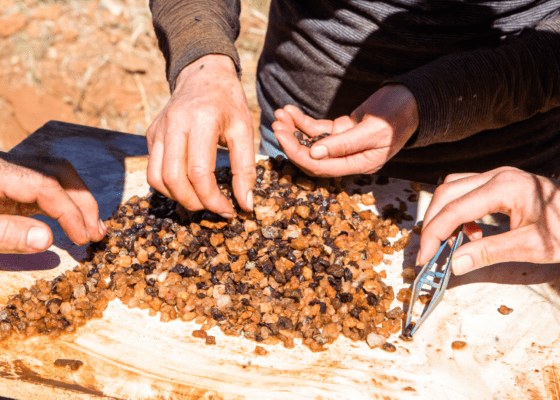
For Enthusiasts: Jewelry enthusiasts appreciate garnet for its versatility and beauty. Its suitability for a variety of jewelry settings makes it a popular choice for personalized jewelry pieces that are not only visually stunning but also carry a wealth of historical and cultural significance.
Celebratory Gem: Garnet is traditionally gifted on the 2nd wedding anniversary, symbolizing the continuance and growth of a relationship. Its connection to January as a birthstone makes it a thoughtful and personal gift for those born in this month, offering a personal touch to birthday celebrations.
Garnet Buying Guide
When purchasing garnet, whether for a collection or as a piece of jewelry, several key considerations should guide your decision:
- Color and Quality: Look for vibrant, even color saturation, which enhances the stone’s aesthetic appeal. The clarity of the garnet also plays a crucial role in its value, although some garnet types like Demantoid are prized even with inclusions that are visually appealing or characteristic of the gem.
- Variety and Rarity: Familiarize yourself with the different types of garnet and their market availability. Rare varieties like Demantoid or Tsavorite can be significantly more expensive than more common types like Almandine or Pyrope.
- Treatment Disclosure: Understand if the garnet has undergone any treatments. Most garnets are not treated, but some may be treated by methods like fracture filling to improve appearance. Treated garnets often require special care and may not be as valuable as untreated stones.
- Vendor Reputation and Certification: Purchase garnet from reputable dealers who provide certification for their gems. This certification should verify the authenticity of the gem and any treatments it has undergone.
- Care and Maintenance: Consider the care requirements for the garnet type you select. While garnets are generally durable, they should be handled with care to avoid damage, and knowledge of proper care techniques will ensure your garnet remains a lasting part of your collection or wardrobe.

By understanding these factors and selecting carefully, collectors and enthusiasts can find high-quality garnets that not only meet their aesthetic criteria but also represent a sound investment in their personal or curated collections.
FAQ Section
What defines a garnet as January’s birthstone? Garnet has been designated as January’s birthstone through historical associations and cultural tradition. It is recognized for its rich color and symbolism of protection and strength, making it ideal for starting the New Year. This tradition has been solidified through listings by major jewelry and gemological associations, recognizing garnet’s widespread appeal and historical significance.
How can you tell a high-quality garnet specimen from a lower-quality one? A high-quality garnet specimen typically exhibits vibrant color saturation, good clarity, and a smooth finish without surface scratches or internal inclusions that are visible to the naked eye. The more vivid and intense the color, and the fewer the inclusions, the higher the quality of the garnet. Exceptional specimens also have a good cut that enhances the gemstone’s natural brilliance and color.
Which garnet varieties are most coveted by mineral collectors? Among the most prized garnet varieties are:
- Demantoid Garnet: Known for its brilliant green hues and fire, often containing unique horsetail inclusions.
- Tsavorite Garnet: Valued for its bright, rich green color, which rivals that of fine emeralds.
- Color Change Garnet: Rare garnets that exhibit different colors in natural and artificial light are particularly fascinating due to their rarity and unique optical properties.
What should collectors look for when acquiring new garnet specimens? Collectors should focus on:
- Rarity and Uniqueness: Opt for garnet varieties that are not commonly found in typical jewelry settings.
- Color and Clarity: Seek out garnets with exceptional color saturation and clarity to ensure the specimen stands out.
- Authenticity and Provenance: Verify the authenticity and geographical origins of the garnet, as these factors can significantly influence its value and desirability.
Conclusion
Reflections on the Enduring Popularity of Garnet Garnet continues to be a favored choice among gem and mineral collectors due to its stunning variety and the depth of history it carries. Its range from vibrant reds to deep greens and even rare color-changing varieties ensures that it never ceases to fascinate and inspire.
Encouragement for Collectors Both novice and experienced collectors are encouraged to delve deeper into the world of garnet. Exploring this gemstone’s rich spectrum and learning about its geological and historical context can greatly enhance any collection. The journey of discovering and collecting garnet not only enriches one’s appreciation of natural beauty but also connects collectors to a broader narrative of earth science and cultural heritage. Through thoughtful collection and study, enthusiasts can continue to celebrate and preserve the legacy of this versatile and magnificent mineral.
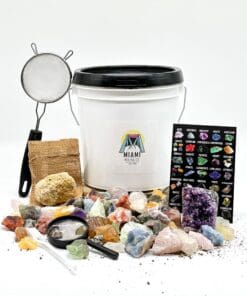 Gem Mining Kit 12 POUNDS of Adventure: Discover Gems and Minerals with our Authentic Mining Kit!
Gem Mining Kit 12 POUNDS of Adventure: Discover Gems and Minerals with our Authentic Mining Kit! 
